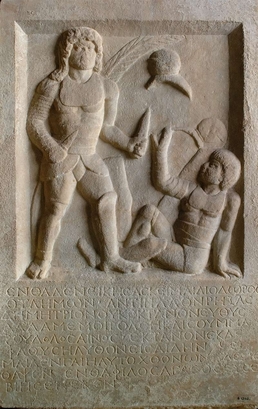Monday, June 20, 2011
Monuments to the Dead and Injustice
Found this on Yahoo - it's the stele for a gladiator from the Black Sea region of Turkey who ended up dead as the result of the "cunning and treachery" of the referee, the summa radis, I believe is the term. Not only is it remarkably clear and unscarred by 1800 years of natural elements, but it also tells a story. The dead gladiator defeated his opponent and stepping back, waited for the verdict from the crowd as to the fate of the other fighter. However, evidently the ref ruled that the man on his butt lost his footing, so he got his weapons back, the fight started over, and the stele marks what was a bad deal for the first winner of the fight. He lost the second go-round.
This monument to injustice survived 1800 years. Do we know anything else about these men? No. Still, doesn't the story resonate even today? Bad calls in sports still happen, but lives aren't lost as a result. Maybe champtionships are lost, and that's a bummer, but a tragedy? Maybe for diehard fans.
Still, think about the bad call in battle, one that costs men their lives. (Pickett's Charge, anyone?) The wrong decision from a biased judge. (*caveat, none of the ones I know.*). The deliberate falsification of evidence. Malfeasance by elected officials that impacts a whole community. We can all think of injustices that happen on a small, local level in this world. Yet will anyone know those story thousands of years from now?
This one lone stele commemorates a death that shouldn't have happened, calls the ref a liar to his face, and manages to engage us artistically as well. That's the sort of monument we don't see anymore.
On the other hand, what if the call was the right one, and the stele is sour grapes? We'll never know.
Subscribe to:
Post Comments (Atom)

No comments:
Post a Comment